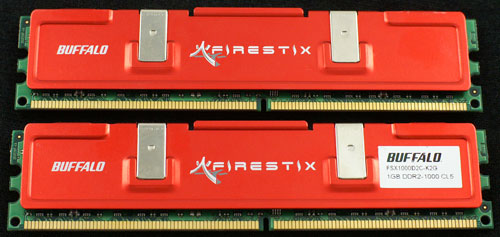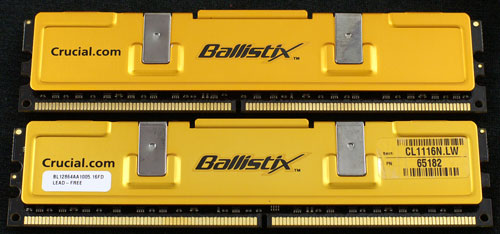High Speed DDR2: Buffalo and Crucial Deliver 1000+
by Wesley Fink on July 7, 2006 12:05 AM EST- Posted in
- Memory
Buffalo FireStix Product Specifications and Information
Buffalo Technology has become a well known manufacturer of memory, wired and wireless network products, and storage solutions. You will find a full range of Buffalo memory products available from many on-line resellers, including regular DIMMs, SO-DIMMs, and Registered memory for servers, desktop computers, and notebooks. Buffalo may not be the first name that comes to mind when Enthusiasts are looking for high-performance memory, but Buffalo has a successful line of Enthusiast products marketed under the FireStix name.

Typical of the FireStix line, the PC2-8000 kits feature bright red heatspreaders. The DIMMs stand out in your installation, and they also carry the extra protection of a lifetime warranty. Rated performance is at 2.1V compared to the DDR2 standard voltage of 1.8V, with DDR2-1000 timings specified as 5-5-5. Both 1GB (2x512MB) and 2GB (2x1GB) kits are available in the DDR2-1000 (PC2-8000) speed. The Part Number for the tested 2GB kit is FSX1000D2C-K2G.
Additional Information is available at the Buffalo website. There are also instructions on the website for returning memory for repair or replacement under the Lifetime Memory Warranty
Crucial Ballistix Product Specifications and Information
The DDR2 market enjoyed some incredible DDR2 performance early in its life with a Micron DDR2 chip that we have since come to know as Fat Body D9. Everyone who made DDR2 used these chips because the performance was so outstanding, and when Micron decided to discontinue them last year, memory makers began scrambling for a replacement. Thus far, they haven't found a new DDR2 chip with the same low latency and high frequency capabilities of the now legendary Micron chips.
Earlier this year a new buzz began that Micron and their Crucial direct sales arm would be introducing a new and even better DDR2 memory chip. In early April we tested OCZ PC2-8000, the first memory to use the new Micron DDR2 memory chips. Now, almost 3 months later, with the AM2 launch behind and the Core 2 Duo launch around the corner, we get our first glimpse of the Crucial modules based on the new DDR2 chips.
Crucial is the retail arm of Micron - the huge US memory maker located in Boise, Idaho. Crucial is primarily a direct sales arm, providing Internet and telephone sales to memory buyers looking for almost any kind of memory for their computers, laptops, and servers. Crucial calls their performance memory Ballistix, and reserves the name for just a small percentage of their top-performing memory.

Test DIMMs were a 2GB kit composed of two 1GB DIMMs. DIMMs were supplied with the distinctive copper/mustard colored Ballistix heatspreaders. The Ballistix 2GB Kit carries a Part Number of BL2KIT12864AA1005. Crucial Ballistix products carry a Lifetime replacement warranty. They are also guaranteed to meet the specifications published on the Crucial website for that specific Ballistix product.
The Ballistix line of DDR2 Memory is extensive, ranging from single 256MB to 1GB DIMMs all the way to 512MB, 1GB, and 2GB kits of matched pairs of DIMMs. DDR2 memory speeds available in the Ballistix line include PC2-4200, PC2-5300, PC2-6400,and PC2-8000 (DDR2-533 to DDR2-1000). Orders may be placed directly at the Crucial website.
Buffalo Technology has become a well known manufacturer of memory, wired and wireless network products, and storage solutions. You will find a full range of Buffalo memory products available from many on-line resellers, including regular DIMMs, SO-DIMMs, and Registered memory for servers, desktop computers, and notebooks. Buffalo may not be the first name that comes to mind when Enthusiasts are looking for high-performance memory, but Buffalo has a successful line of Enthusiast products marketed under the FireStix name.

Typical of the FireStix line, the PC2-8000 kits feature bright red heatspreaders. The DIMMs stand out in your installation, and they also carry the extra protection of a lifetime warranty. Rated performance is at 2.1V compared to the DDR2 standard voltage of 1.8V, with DDR2-1000 timings specified as 5-5-5. Both 1GB (2x512MB) and 2GB (2x1GB) kits are available in the DDR2-1000 (PC2-8000) speed. The Part Number for the tested 2GB kit is FSX1000D2C-K2G.
| Buffalo FireStix PC2-8000 Memory Specifications | |
| Number of DIMMs and Banks | 2 DS |
| DIMM Size Total Memory |
1GB 2GB |
| Rated Timings | 5-5-5 at DDR2-1000 |
| Rated Voltage | 2.1V |
Additional Information is available at the Buffalo website. There are also instructions on the website for returning memory for repair or replacement under the Lifetime Memory Warranty
Crucial Ballistix Product Specifications and Information
The DDR2 market enjoyed some incredible DDR2 performance early in its life with a Micron DDR2 chip that we have since come to know as Fat Body D9. Everyone who made DDR2 used these chips because the performance was so outstanding, and when Micron decided to discontinue them last year, memory makers began scrambling for a replacement. Thus far, they haven't found a new DDR2 chip with the same low latency and high frequency capabilities of the now legendary Micron chips.
Earlier this year a new buzz began that Micron and their Crucial direct sales arm would be introducing a new and even better DDR2 memory chip. In early April we tested OCZ PC2-8000, the first memory to use the new Micron DDR2 memory chips. Now, almost 3 months later, with the AM2 launch behind and the Core 2 Duo launch around the corner, we get our first glimpse of the Crucial modules based on the new DDR2 chips.
Crucial is the retail arm of Micron - the huge US memory maker located in Boise, Idaho. Crucial is primarily a direct sales arm, providing Internet and telephone sales to memory buyers looking for almost any kind of memory for their computers, laptops, and servers. Crucial calls their performance memory Ballistix, and reserves the name for just a small percentage of their top-performing memory.

Test DIMMs were a 2GB kit composed of two 1GB DIMMs. DIMMs were supplied with the distinctive copper/mustard colored Ballistix heatspreaders. The Ballistix 2GB Kit carries a Part Number of BL2KIT12864AA1005. Crucial Ballistix products carry a Lifetime replacement warranty. They are also guaranteed to meet the specifications published on the Crucial website for that specific Ballistix product.
| Crucial Ballistix PC2-8000 Memory Specifications | |
| Number of DIMMs and Banks | 2 DS |
| DIMM Size Total Memory |
1GB 2GB |
| Rated Timings | 5-5-5-15 at DDR2-1000 |
| Rated Voltage | 2.2V |
The Ballistix line of DDR2 Memory is extensive, ranging from single 256MB to 1GB DIMMs all the way to 512MB, 1GB, and 2GB kits of matched pairs of DIMMs. DDR2 memory speeds available in the Ballistix line include PC2-4200, PC2-5300, PC2-6400,and PC2-8000 (DDR2-533 to DDR2-1000). Orders may be placed directly at the Crucial website.










24 Comments
View All Comments
JarredWalton - Friday, July 7, 2006 - link
We're working on more memory reviews, and Corsair's offering will be reviewed soon.araczynski - Monday, July 10, 2006 - link
didn't know that was an option, but that's ok, with the adblock solution i get to kill many birds with one stone.araczynski - Friday, July 7, 2006 - link
...i'm getting fed up with the damn intellitext ads all over the place, anyone know of a surefire way to block that crap?TIA
araczynski - Friday, July 7, 2006 - link
NM, found adblock for firefox, brilliant!JarredWalton - Friday, July 7, 2006 - link
Another option is to simply http://www.anandtech.com/siteinfo.aspx?intelli=y">turn it off in your site preferences. :)lopri - Friday, July 7, 2006 - link
Excellent review in that it shed light on DDR2 testing methodology on Intel platform. I should admit that I'd been quite ignorant about DDR2 scaling to this date. This article exaplains alot about the way Intel platform works and how dividers are used - in plain English. It seems, in a sense, it's easier to test memory on Intel platform, especially once Conroe arrives, with so many dividers available at any given CPU clock.Thanks for an excellent review. BTW, when can we expect the P5W-DH review and/or DFI 975X Infinity review?
lop
*nitpick1 : On page 5, there is a typo. ;)
Wesley Fink - Friday, July 7, 2006 - link
Thanks, Lopri. The typo is now corrected.Now that AMD has moved to DDR2 with AM2, memory dividers and memory speeds work exactly the same, with standard supported speeds to DDR2-800.
The P5W-DH review will post next week.
semo - Saturday, July 8, 2006 - link
why don't you make a dedicated error reporting section for each article?last page fifth paragraph:
shoudln't that be "amd platform"
Wesley Fink - Saturday, July 8, 2006 - link
We were talking about how Intel handles memory speed which is why AMD was not also mentioned. DDR-533 is DDR-533 on BOTH the Intel and AMD platform. However, the CPU clock speed on the AMD platform is 400, while the bus speed on the Intel is 1066. AMD double pumps 200 on the clock to achieve 400, while the latest Intel processors quad pump 266 to achieve 1066. The BASE speed is still 200 AMD and 266 Intel.1:1 on the AMD is therefore DDR2-400, but Hyper Transport and the on-chip memory controller on AM2 means the memory speed or ratios don't really matter. There is no penalty for running AM2 at ratios, but there is a very slight penalty for running Intel at other than 1:1 (DDR2-533) - in the range of 1% to 5% memory bandwidth reduction.
The AM2 has massive DDR2 memory bandwidth, but it is not memory-starved and really can't use the extra bandwidth in the current CPU design. It might matter more in future AMD designs.
semo - Sunday, July 9, 2006 - link
ok thanks i think i get it now. and it's a shame amd can't take advantage of the advances ddr2 has made (apart from the reduction in penalty going from ddr to ddr2)